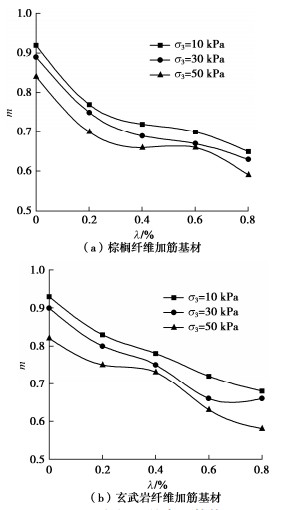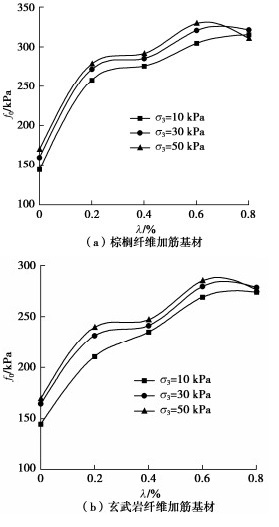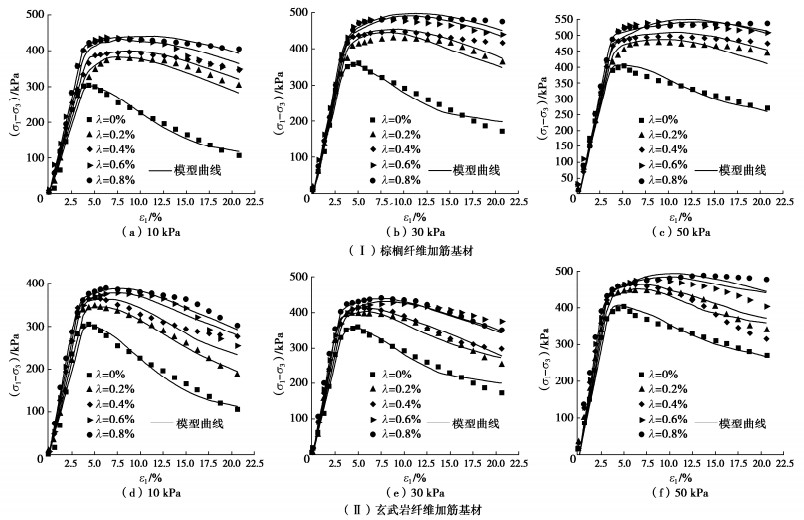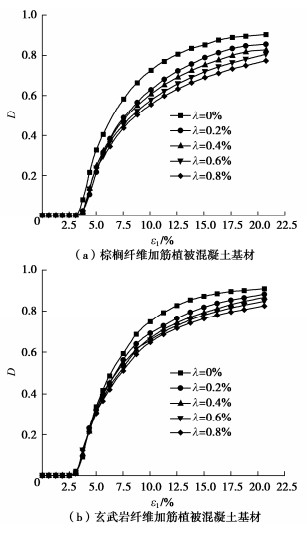Statistical damage model for fiber-reinforced vegetation concrete substrate
-
摘要: 为研究纤维加筋植被混凝土基材的本构模型和损伤演化规律,考虑围压和纤维掺量两个因素,基于Weibull分布建立了能反映基材力学特性的统计损伤模型,给出了模型参数的确定方法,探讨了Weibull分布参数与围压、纤维掺量的关系。利用该模型对基材三轴试验结果进行对比验证;根据基材的破坏准则,推导了损伤阈值的确定方法;通过分析损伤演化特征与微元体的失效过程,对基材应力–应变关系和损伤软化规律进行了阐释。分析结果表明该模型曲线与试验结果吻合度较高,能较好反映纤维加筋基材加载过程中的损伤软化特性;加筋基材损伤阈值与峰值应变之比保持在0.4~0.6之间。本文研究为准确分析和评价基材的力学性质提供了理论参考。Abstract: This study attempts to investigate the constitutive model and damage evolution law of the fiber-reinforced vegetation concrete substrate. Taking the two factors of confining pressure and fiber content into account, a statistical damage model that can reflect the mechanical properties of the substrate is established based on the Weibull distribution. The method for determining model parameters is given, and the relationship among the Weibull distribution parameters, the confining pressure and the fiber contents is discussed. The model is then used to verify the results of the triaxial tests on the substrate. According to the destruction criterion of the substrate, the method for determining the damage threshold is deduced. By analyzing the damage evolution characteristics and the failure process of the micro-element, the stress-strain relationship and the law of damage softening of the substrate are elaborated. The results show that the model curves agree well with the tests, which can reflect the damage softening characteristics during the loading process of the fiber-reinforced substrate. Besides, the ratio of the damage threshold to the peak strain is found to range from 0.4 to 0.6. This study provides a theoretical reference for the accurate analysis and evaluation of the mechanical properties of substrate.
-
-
表 1 纤维加筋基材抗剪强度测试值
Table 1 Values of shear strength tests on fiber-reinforced substrate
λ/% 棕榈纤维加筋基材 玄武岩纤维加筋基材 c/kPa φ/(°) c/kPa φ/(°) 0 75.4 33.7 75.4 33.7 0.2 95.5 33.4 86.6 33.5 0.4 99.0 33.9 91.1 33.7 0.6 104.0 34.0 94.1 33.3 0.8 108.3 34.1 97.4 33.7 表 2 棕榈纤维加筋基材弹性模量实际值与拟合值
Table 2 Actual and fitted values of elastic modulus of palm fiber-reinforced substrate
λ/% σ3=10 kPa σ3=30 kPa σ3=50 kPa 试验值/MPa 拟合值/MPa 相对误差 试验值/MPa 拟合值/MPa 相对误差 试验值/MPa 拟合值/MPa 相对误差 0 7.98 7.78 -0.0251 10.16 10.55 0.0384 11.95 11.84 -0.0092 0.2 8.63 8.55 -0.0093 10.80 11.19 0.0361 12.62 12.41 -0.0166 0.4 9.66 9.32 -0.0352 11.66 11.83 0.0146 12.77 12.99 0.0172 0.6 11.30 10.10 -0.1062 12.36 12.46 0.0081 13.61 13.56 -0.0037 0.8 11.46 10.87 -0.0515 12.52 13.10 0.0463 13.61 14.14 0.0389 表 3 玄武岩纤维加筋基材弹性模量实际值与拟合值
Table 3 Actual and fitted values of elastic modulus of basalt fiber-reinforced substrate
λ/% σ3=10 kPa σ3=30 kPa σ3=50 kPa 试验值/MPa 拟合值/MPa 相对误差 试验值/MPa 拟合值/MPa 相对误差 试验值/MPa 拟合值/MPa 相对误差 0 7.98 7.87 -0.0132 10.16 10.86 0.0691 11.95 12.25 0.0249 0.2 8.60 8.83 0.0270 12.58 11.88 -0.0552 13.83 13.23 -0.0432 0.4 10.34 9.79 -0.0531 12.88 12.90 0.0020 14.76 14.21 -0.0371 0.6 10.71 10.75 0.0037 13.62 13.93 0.0225 15.21 15.19 -0.0007 0.8 11.74 11.71 -0.0023 14.67 14.95 0.0186 16.21 16.18 -0.0023 表 4 纤维加筋基材损伤阈值(σ3=30 kPa)
Table 4 Damage thresholds of fiber-reinforced substrate (σ3=30 kPa)
λ/% 棕榈纤维加筋基材 玄武岩纤维加筋基材 εd/% εd/εp εd/% εd/εp 0 2.81 0.58 2.73 0.55 0.2 3.16 0.51 2.76 0.57 0.4 3.12 0.45 2.88 0.56 0.6 3.08 0.49 2.51 0.43 0.8 3.04 0.49 2.43 0.47 注:λ=0(空白试样)Efc分别采用式(15),(16)计算。 -
[1] 夏振尧, 许文年, 王乐华. 植被混凝土生态护坡基材初期强度特性研究[J]. 岩土力学, 2011, 32(6): 1719–1724. doi: 10.3969/j.issn.1000-7598.2011.06.021 XIA Zhen-yao, XU Wen-nian, WANG Le-hua. Research on characteristics of early strength of ecological slope-protected base material of vegetation-growing concrete[J]. Rock and Soil Mechanics, 2011, 32(6): 1719–1724. (in Chinese) doi: 10.3969/j.issn.1000-7598.2011.06.021
[2] 水电工程陡边坡植被混凝土生态修复技术规范: NB/T 35082—2016[S]. 2016. Technical Code for Eco-Restoration of Vegetation Concrete on Steep Slope of Hydropower Projects: NB/T 35082—2016[S]. 2016. (in Chinese)
[3] 潘波, 丁瑜, 黄晓乐, 等. 棕榈纤维加筋植被混凝土三轴试验研究[J]. 硅酸盐通报, 2020, 39(4): 1153–1159. https://www.cnki.com.cn/Article/CJFDTOTAL-GSYT202004020.htm PAN Bo, DING Yu, HUANG Xiao-le, et al. Triaxial experimental study on palm fiber-reinforced vegetation concrete[J]. Bulletin of the Chinese Ceramic Society, 2020, 39(4): 1153–1159. (in Chinese) https://www.cnki.com.cn/Article/CJFDTOTAL-GSYT202004020.htm
[4] 沈珠江, 胡再强. 黄土的二元介质模型[J]. 水利学报, 2003(7): 1–6. doi: 10.3321/j.issn:0559-9350.2003.07.001 SHEN Zhu-jiang, HU Zai-qiang. Binary medium model for loess[J]. Journal of Hydraulic Engineering, 2003(7): 1–6. (in Chinese) doi: 10.3321/j.issn:0559-9350.2003.07.001
[5] KRAJCINOVIC D, SILVA M A G. Statistical aspects of the continuous damage theory[J]. International Journal of Solids and Structures, 1982, 18(7): 551–562. doi: 10.1016/0020-7683(82)90039-7
[6] KUMAR PANDEY P, SINGH K K, GAURAV A. Mechanical properties of woven GFRP angle ply laminates: a statistical analysis based on two parameters weibull distribution[J]. Materials Today: Proceedings, 2020, 22: 1318–1325. doi: 10.1016/j.matpr.2020.01.424
[7] CUI T, HE H X, YAN W M, et al. Compression damage constitutive model of hybrid fiber reinforced concrete and its experimental verification[J]. Construction and Building Materials, 2020, 264: 1–11.
[8] 朱振南, 蒋国盛, 田红, 等. 基于Normal分布的岩石统计热损伤本构模型研究[J]. 中南大学学报(自然科学版), 2019, 50(6): 1411–1418. https://www.cnki.com.cn/Article/CJFDTOTAL-ZNGD201906020.htm ZHU Zhen-nan, JIANG Guo-sheng, TIAN Hong, et al. Study on statistical thermal damage constitutive model of rock based on normal distribution[J]. Journal of Central South University (Science and Technology), 2019, 50(6): 1411–1418. (in Chinese) https://www.cnki.com.cn/Article/CJFDTOTAL-ZNGD201906020.htm
[9] 张明, 王菲, 杨强. 基于三轴压缩试验的岩石统计损伤本构模型[J]. 岩土工程学报, 2013, 35(11): 1965–1971. https://www.cnki.com.cn/Article/CJFDTOTAL-YTGC201311003.htm ZHANG Ming, WANG Fei, YANG Qiang. Statistical damage constitutive model for rocks based on triaxial compression tests[J]. Chinese Journal of Geotechnical Engineering, 2013, 35(11): 1965–1971. (in Chinese) https://www.cnki.com.cn/Article/CJFDTOTAL-YTGC201311003.htm
[10] DENG J, GU D S. On a statistical damage constitutive model for rock materials[J]. Computers & Geosciences, 2011, 37(2): 122–128.
[11] 周永强, 盛谦, 冷先伦, 等. 考虑残余强度和阈值影响的岩石弹性损伤统计模型[J]. 长江科学院院报, 2016, 33(3): 48–53. https://www.cnki.com.cn/Article/CJFDTOTAL-CJKB201603013.htm ZHOU Yong-qiang, SHENG Qian, LENG Xian-lun, et al. Statistical constitutive model of elastic damage for rock considering residual strength and threshold[J]. Journal of Yangtze River Scientific Research Institute, 2016, 33(3): 48–53. (in Chinese) https://www.cnki.com.cn/Article/CJFDTOTAL-CJKB201603013.htm
[12] JEAN L. How to use damage mechanics[J]. Nuclear Engineering and Design, 1984, 80(2): 233–245. doi: 10.1016/0029-5493(84)90169-9
[13] ZHAO H, SHI C J, ZHAO M H, et al. Statistical damage constitutive model for rocks considering residual strength[J]. International Journal of Geomechanics, 2017, 17(1): 04016033. doi: 10.1061/(ASCE)GM.1943-5622.0000680
[14] DUNCAN J M, CHANG C Y. Nonlinear analysis of stress and strain in soils[J]. Journal of the Soil Mechanics and Foundations Division, 1970, 96(5): 1629–1653.
[15] 胡亚元, 余启致, 张超杰, 等. 纤维加筋淤泥固化土的邓肯-张模型[J]. 浙江大学学报(工学版), 2017, 51(8): 1500–1508. https://www.cnki.com.cn/Article/CJFDTOTAL-ZDZC201708004.htm HU Ya-yuan, YU Qi-zhi, ZHANG Chao-jie, et al. Duncan-Chang model for fiber reinforced solidified sludge[J]. Journal of Zhejiang University (Engineering Science), 2017, 51(8): 1500–1508. (in Chinese) https://www.cnki.com.cn/Article/CJFDTOTAL-ZDZC201708004.htm
[16] XIE S J, LIN H, WANG Y X, et al. A statistical damage constitutive model considering whole joint shear deformation[J]. International Journal of Damage Mechanics, 2020, 29(6): 988–1008.
[17] 李树春, 许江, 李克钢, 等. 基于Weibull分布的岩石损伤本构模型研究[J]. 湖南科技大学学报(自然科学版), 2007, 22(4): 65–68. https://www.cnki.com.cn/Article/CJFDTOTAL-XTKY200704016.htm LI Shu-chun, XU Jiang, LI Ke-gang, et al. Study on damages constitutive model of rocks based on weibull distributing[J]. Journal of Hunan University of Science & Technology (Natural Science Edition), 2007, 22(4): 65–68. (in Chinese) https://www.cnki.com.cn/Article/CJFDTOTAL-XTKY200704016.htm
[18] KAWAMOTO T, ICHIKAWA Y, KYOYA T. Deformation and fracturing behaviour of discontinuous rock mass and damage mechanics theory[J]. International Journal for Numerical and Analytical Methods in Geomechanics, 1988, 12(1): 1–30.
[19] XU Y, YANG R Z. Dynamic mechanics and damage evolution characteristics of rubber cement mortar under different curing humidity levels[J]. Journal of Materials in Civil Engineering, 2020, 32(10): 04020309.



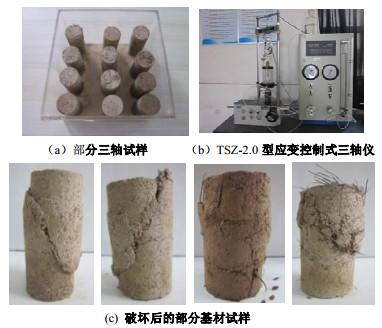
 下载:
下载:
